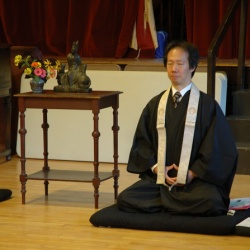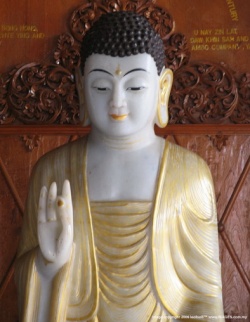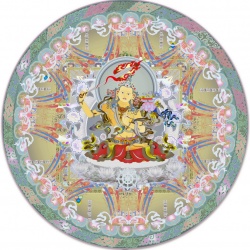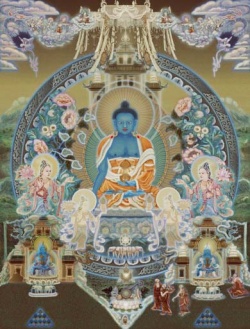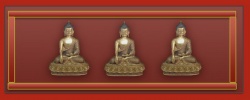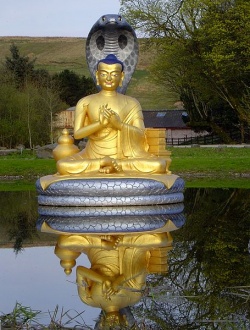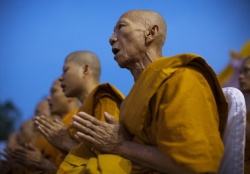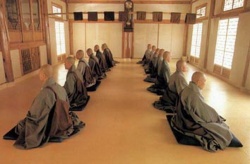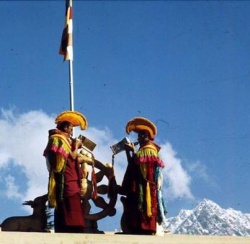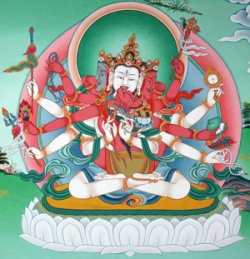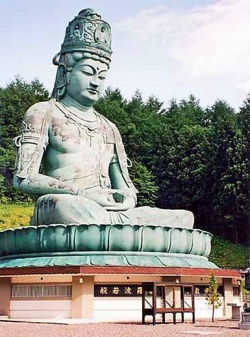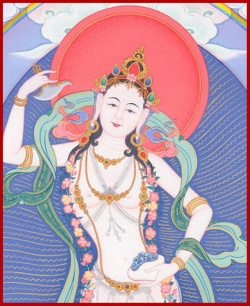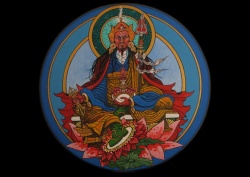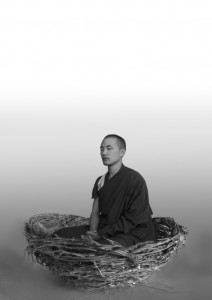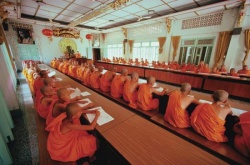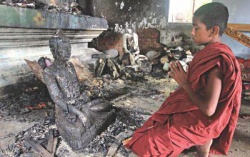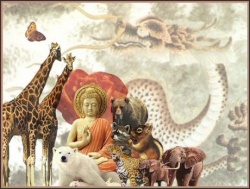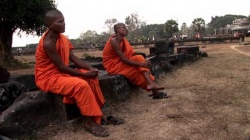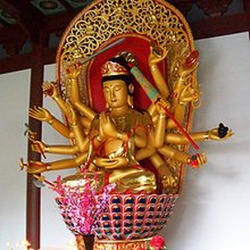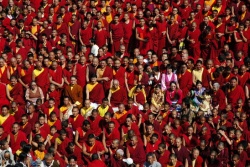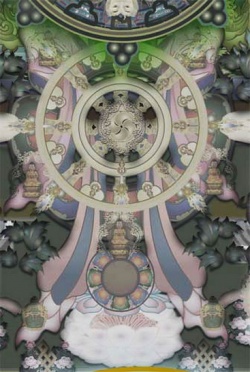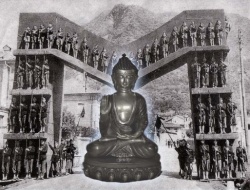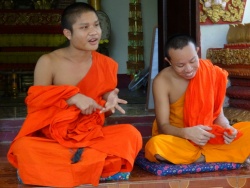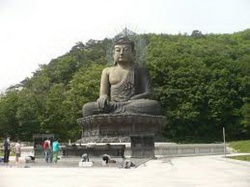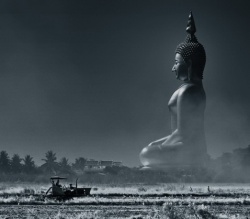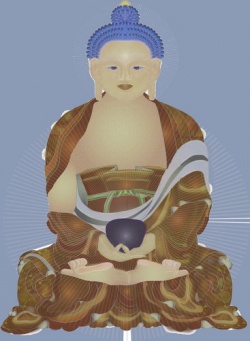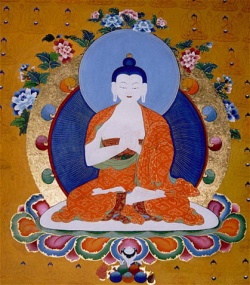The beginning object of meditation practice
TRANSLATOR IS PREFACE
May all sentient beings,all who are involved in the suffering of birth, decay and death, be well and happy, free from sufferings.
It gives me great happiness to be able to serve my teacher, Phra Krusangvorn Samadhivatra by translating his Vipassana manual which you are now holding in your hands.
Although this is a very little translation, still it is my first attempt to translate a Thai intrution book into English, and I feel that this manual can be of much
use and benefit to beginners in their understanding and effort to open their minds to Vipassana meditation practice.
If there are any shortcomings in my work it would be a great kindness to inform me of them. I would be thankful for your best wishes to help me.
May I offer the merit of this Buddhist work to Mrs. Kong Phayuwongse,my kind and beloved mother who passed away from me when I was eight years old. May she be happy in her own world.
I wish to thank Cecitie K wiat who is now ordained as nun Jiva Tantra at Wat Pleng in Thonburi, Thailand, for her kind help in correcting this translation. Also I would like to thank Miss Mary Craig, Mr.John Ball, and Mr. And Mrs. Robins and
their son, Simon for their kindness and hospitality to me while I was doing the work of this translation.
Phra Prasert Chantarangsi
FREFACE
Because fellow Buddhists have asked me to set out in brief form a manual of Vipassana practice, I have gathered together information which may be helpful to begin practice of Vipassana. I have based the contents of this work on my own experiences.
Both Samatha (tranquillity meditation) and Vipassana (insight meditaiton) are suitable for a pracitioner who has only a short opportunity to do pratice. Thai people who come to do either type of ptactice at Wat Pleng Meditation Center use this hand book-with good results, I am hopeful thai this work will prove of benefit to the receivers and will be of further guidance in their attainment of nibbana.
May sympathetic Joy return to all whose money was given to support this work.
May they succeed in right ways according to their wishes.
May the Lord Buddha; the Dhamma, his teaching: and the Sangha, his disciples protect them form suffering, sadness and disease; and all enemies be removed from them.
May they have great Sila (virtue), Samadhi (doncentration) and Panna (wisdom) until Nibbana is attained.
Ven. Phrakrusangvornsamadhivatra
SAMATHA
(ANAPANASAI)
A brief outline for beginners.
Preparation
1. Take a bath to cleanse the body.
2. Undertake five or eight precepts.
3. Pay respect to the Lord Buddha, to the teacher of his meditation; and chant.
4. Undertake the practice, using the object
Of meditation given by the teacher, Asking for the meditation object
Ukasa at this time, as I undertake the meditation object, may kanika Samadhi, Uppacara
Samadhi, Appanna and Vipassana (Insight wisdom) arise in me. I will set my mindfulness on my breathing. From now I will know the in-breath and the out-breath. I will be aware of three breaths, of seven breaths, of a hundred breaths, and a thousand breaths. I will carefully develop mindfulness of breath.
“In concentration one distinguishes three grades of intensity.”
(1) Preparatory concentration at the beginning of the mental exercise
(2) Neighbourhood concentration-approaching but not yet attaining the first absorbtion (Jhana).
(3) Attainment concentration-that concentration which is present during absorbtion.
HOW TO PRACTICE
Sit cross-legged, with the right leg resting on the left leg, right hand on the left hand, make the spine as straight as possible but try to be comfortable.
Close the eyes and release the mind from any attachment to outer existence. With the mind and body comfortably arranged, allow the breath to settle into an even flow not too harsh, not too soft. Do not use force to attain this flow. Mindfulness should center on the breathing to know inhalation and exhalation, watching at the place where the breath touches the nose-tip. At this point, one should know the breath thoroughly, don’t think about any other happening, but keep the concentration at the place where you feel the breath touching the nose tip for from thirty minutes to an hour, or two hours, or five. What ever time has been set for practice, try to maintain one-pointed a awareness for that period. At the end of the practice time, develop and spread metta (loving-kindness) in all directions to all beings.
METTA MEDITATION AND CHANT
Sabbe satta avera hontu, abbyapa jjha hon’u, anigha-hontu, sukhi attanam pariharantu. (May all beings be free emnity, disease and grief, and may they be happy,)
May I set my attention on truth, may the merit accrued be my past actions of giving, by undertaking to live according to the precepts, and by working to develop the mind be support to me, so I my attain insight wisdom in this birth and my next birth and however many births it takes to end suffering-until Nibbana is attained
VIPASSNA-FIRST STEPS
1. Look for a suitable place to practice meditation.
2. Look for food suitable to the needs of meditation.
3. Be located near a teacher suitable to the meditation.
4. Study the structure or Vipassana practice knowledge is well established.
5. Pay homage to Lord Buddha, His teaching and His disciples and chant the refuges.
6. Undertake five or eight precepts and the Vipassana object.
OFFERING TO BUDDHA
Imaham Bhante Bhagava Attabavan Tuhakam (Bhagavato) pariccajha mi.
Sire, the Lord Buddha, Excellent One, may I humbly offer my body and mind to
you.
OFFERING TO TEACHER
Imaham Bhante Achariya Attabavan. Tumhakum (Acariyassa) Pariccajhami.
Venerable Sir, Teacher, may I humbly offer my body and mind to you.
ASKING FOR VIPASSANA OBJECT FROM TEACHER
Nibbanassa me Bhante Sacchikaranatthaya kammatthanam dehi.
Venerable Sir, please give me the object of Vipassana meditation practice to develop my mind so I may attain Nibbana.
Ukasa, Ukasa, may I receive instruction for meditation. May Khanika Samadhi (preparatory concentration),
Uppacara Samadhi (approach concentration),
Appanna Samadhi (Attainment concentration) and
Vipassana nana occur in my practice,
While seeing, I will be mindful at the eye-door. I will acknowledge eye and object at Rupa (matter) and seeings as Nama (consciousness). I will be mindful at the ear-door and acknowledge sound as rupa and hearing as nama. While smelling I will be mindful at the nose-door and acknowledge smell as rupa and smell-consciousness as nama. While tasting I will be mindful of taste as rupa and taste-consciousness as nama. While touching I will acknowledge, by mindfulness of body, coldness, heat, hardness or softness as rupa and feeling as nama. While thinking, I will have mindfulness of the heart and acknowledge the heart as rupa and thought as nama (consciousness). While standing, I will be mindful of position and acknowledge the body standing as rupa and the consciousness as nama. In walking, I will be mindful of the foot moving and acknowledge the moving as rupa and the consciousness of moving as nama. While sitting, I will be mindful of postion and acknowledge the body sitting as rupa and the consciousness of sitting as nama. While lying, I will be mindful of position and acknowledge body lying as rupa and consciousness as nama. While moving any part of the body, I will acknowledge the moving part as rupa and the consciousness as nama. I will try to maintain full mindfulness at every moment of the here and now. I will not lack mindfulness while cleaning the mouth, dressing, bathing, eating, going, to sleep, waking washing the face and going to the toilet. I will try to be mindful of all my works. I will observe the following rules of practice:
1. abstain from reading and writing.
2. abstain from sleeping in the day time, from long sleep at night in order to do more practice.
3. abstain from speech, except with the teacher.
4. abstain from social meetings-if it is necessary to meet with someone, I will speak very little and maintain mindfulness of the sense doors.
5. continuously make the effort to guard the sense doors with mindfulness and to maintain the level of awareness unless sleep or distractions interfere.
6. know the quantity of food eaten, eating neither too little nor too muck and no intoxicants.
7. have awareness of mind with every movement continuously.
8. have awareness of the rising and falling of consciousness, keeping concentration on the mind flow from meditation object to sense doors. Try not to break this awareness.
Try to have mindfulness of Nama and Rupa or the state of Dhamma as according to the Buddha’s teaching as it exists at each moment, so that purity of Sila (virtue), purity of mind, purity of view, kangkha vitarana visuddhi (overcoming of doubt), maggamagganan visuddhi ([[purity of knowledge and vision of path progress, and nanadassana visuddhi (purity of knowledge and vision) will arise and from this moment progress to awakening.
Continuously make the effort to have mindfulness of Nama and Rupa.
To progress along the way of development of Enlightenment. One must follow the eight-fold path (attganagga) which is:
1. Sanna ditthi-right view (understanding)
2. Samma sankappa-right thought
3. Samma vaca-right speech
4. Samma kammanta-right bodily action
5. Samma ajiva-right livlihood
6. Samma vayama-right effort
7. Samma sati-right mindfulness
8. Samma samadhi-right concentration
The eightfold path must be followed in order to tread the middle way so one will realize the present Dhamma (teaching or truth). If one follows this path, the mind cannot cling to pannatti (relative or mundane truth) and therefore cannot harbor greed, haired or delusion. Rather will mindfulness, concentration and wisdom suitable to the practice of meditation arise.
NOTE: After receiving the meditation object from the teacher, the practitioner will go to his place of practice and lignt candles and joiss sticks to worship the Triple Gem (the Buddha, the Dhamma and the Sangha). This is material worship. To do practice is mental worship. He should make his resolution strong by recollecting the Triple Gem, the virtue of his parents, his preceptor, his teachers and all persons who have supported him. He should consider the virtue of the Devas who have right view and support and protect the Buddhist teaching. Then he should set up strong resolution as follows:
In this practice which I now undertake, if I do not easily develop a good mind state, may I continue my effort, continue trying with every thought. Even were my body to fall to pieces, my blood to dry up and disappear until only the bones remain, still may I try with great effort, sacrifice all my powers to gain awakenin-to see the truth of Nibbana.
After making redolution, one should clear the heart and spread good will and loving kindness toall.
TO DEVELOP LOVING-KINDNESS IN SELF
Aham sukhito homi-may I be happy
Aham nidukkho homi-may I be free from suffering
Aham avero homi-may I be free of enmity
Aham appyapacco homi-may I be free of envy
Aham anigo homi-may I be from malice
Sukhi attanam pariharami-may I be well and happy
OFFERING LOVING-KINDNESS TO OTHERS
Sabbe satta-all beings
Sabbe dana-all living things
Sabbe bhuta-all creatures
Sabbe puggala-all persons
Sabbe attabhavapariyapanna-all who have arrived at a state of individuality
Sabbe itthiyo-all women
Sabbe purisa-all men
Sabbe ariya-all ariyas
Sabbe deva-all devas
Sabbe vinipatika-all devils
Avara hontu appyapacca hontu aniga hontu sukhi attanam paritharantu-May they be free of envy, free of malice, May they be well and happy.
TO OFFER LOVING-KINDNESS IN THE TEN DIRECTIONS
Parutthi mayadisaya sabbe satta sukhita hontu-may all sentient beings to the east be happy
Dukkhinaya disaya sabbe satta sukhita hontu-may all sentient beings to the south be happy
Pacchimaya disaya sabbe satta sukhita hontu-may all sentient beings to the west
be happy.
Uttaraya disaya sabbe satta sukhita hontu-may all sentient beings to the north be happy.
Puratthimaya anudisaya sabbe satta sukhita hontu-may all sentient beings to the southeast be happy.
Dukkhinaya anudisaya sabbe satta sukhita hontu-may all sentient beings to the southwest be happy.
Uttaraya anudisaya sabbe satta sukhita hohtu-may all sentient being to the northeast be happy.
Hethimaya anudisaya sabbe satta sukhita hontu-may all sentient beings below be happy.
Uparimaya anudisaya sabbe satta sukhita hontu-may all sentient beings above be happy.
NOTE: After offering loving-kindness, nama-rupa awareness will be practiced continously until you consciously give up the practice. During practice, the teacher will guide and test the degree of awareness, give advice and make changes in the meditation one must first consult the teacher.
SIX GROUNDS OF VIPASSANA
The grounds of Vipassana preached by Lord Buddha were divided into six parts which are in brief as follows:
1. five khanda (groups)
2. twelve sense organs
3. eighteen dhatu (elements)
4. twenty two indriya (faculites)
5. four ariya sacca (noble truths)
6. twelve paticcasamuppada (the wheel of life)
There are four paramatthadhamma (highest truths), which are;
1. Citta-consciousness 89 (without development of jhana) or 121 (with jhana development). The duty of citta is to know objects.
2. Cetasika-52 mental states. Mental concomitants which are bound up with the
simultaneously arising consciousness the-cetasika comprise feeling, perception and 50 mental formations.
3. Rupa-28 kinds of corporeality-rupa can be broken.
4. Nibbana-1 kind of Nibbana-it is beyond suffering.
GROUND ONE-FIVE KHANDA AND MEANING
1. Rupa Khanda-material-group-due to be spoiled.
2. Vedana khanda-feeling has the duty of feeling.
3. Sanna kanda-percepion has the duty of perceiving objects.
4. Sankhara khanda)-mental formation-has the duty of creating citta and aramana (object).
5. Vinnana-consciousness has the duty to know aramana (objects)
TRANSLATING THE FOUR PARAMATTHA DHAMMA INTO THE FIVE KHANDA
28 Paramattha rupa-rupa khanda
1. Vedana Cetasika-vedana khanda
1: Sanna Cetasika-Sanna khanda
50 Sankhara Cetasika-Sankhara khanda
89-121 Citta-vinnana khanda
Nibbana as khandavimutti-delivered from the five khanda.
FIVE KHANDA AS NAMA-RUPA
1. Rupa khanda as rupa dhamma (matter)
rupa dhamma
2. Vedana khanda as namadhamma cetasika
nama dhamma
3. Sanna khanda as namadhamma cetasika
three cetasika nama dhamma
4. Sankhara khanda as nama dhamma cetasika
mana dhamma
5. Vinnana khanda as namadhamma citta
nama dhamma
In the five khanda there are three nama dhamma mental states and one nama dhamma of consciousness, totally four nama khanda and one rupa khanda. Thus the five khanda can be broken down as composing of nama and rupa.
GROUND TWO-THE TWELVE SENSE ORGANS(AYATANA)
Six internal Organs; Six external Organs;
1. cakkhayatana-eyes rupayatana-colour
2. sotayatana-ears saddayatana-sound
3. kanayatana-nose khandayatana-odour
4. jivhayatanan-tongue rasayatana-touching
5. manayatana-mind dhammayatana-mind
object
THE TWELVE AYATANA AS RUPA-NAMA
Eye and colour are rupa dhamma-seeing is nama dhamma; ear and sound are rupa dhamma-hearing is nama dhamma; nose and smell are rupa dhamma-smelling is nama dhamma; tongue and taste are rupa dhamma-tasting is nama dhamma; body and impressions are rupa dhamma-feeling is namadhamma; bodily postures and heart are rupa dhamma mind is namadhamma.
GROUND THREE-EIGHTEEN ELEMENTS(DHATU)
Dhatu are divided into three kinds; receiving, attaching and consciouness.
Receiving Dhatu
1. Chakkhudhatu-eye as rupa
2. Sotadhatu-ear as rupa
3. Ganadhatu-nose as rupa
4. Jivhadhatu-tongue as rupa
5. Kaya dhatu-body as rupa
6. Manodhatu-mind as nama
Attaching Dhatu
1. Chakkhudhatu-colour as rupa
2. Saddha dhatu-sound as rupa
3. Gandha dhatu-odour as rupa
4. Rasa dhatu-taste as rupa
5. Photthabba dhatu body and impression as rupa
6. Dhamma dhatu-mind object as nama-rupa
Dhatu Consciousness
1. Cakkhu vinnana dhatu-eye consciousness as nama
2. Sota vinnana dhatu-ear consciousness as nama
3. Cana vinnana dhatu-nose consciousness as nama
4. Kaya vinnana dhatu-body consciousness as nama
5. Mano vinnana dhatu-mind consciousness as nama
Of the eighteen dhatu, ten are nama only, seven are rupa only, but one is both nama and rupa. The entire eighteen dhatu can be summarized as rupa dhatu, nama dhatu, rupa dhamma and nama dhamma.
THE FOURTH GROUP-TWENTY
TWO INDRIYA(FACULTIES)
1.Chakkhindariya-eye-rupa
2. Sotindariya-ear-rupa
3. Ganindariya-nose-rupa
4. Jivhindariya-tongue-rupa
5. Kayindariya-bod-rupa
6.Itthindariya-femininty-rupa
7.Purisindariya-masculinity-rupa
8.Jivitindariya-vitality-nama-rupa
9.Manindariya-mind-nama
10. Sukkhindariya-pleasant bodily feeling-nama
11. Dukkhindariya-bod ly pain-nama
12. Somanassindariya-gladness-nama
13. Domanassindariya-sadness-nama
14. Upekkhindariya-indifference-nama
15. Sachindariya-faith-nama
16. Viriyindariya-energy-nama
17. Satindariya-mindfulness-nama
18. Samathindariya-concentration-nama
19. Panyindariya-wisdom-nama
20. An-unna tannassamitindriya-the assurance of “I shall know what I do-not yet know” –nama
21. Annindariya-the faculty of highest knowledge
22. Annatavidriya-the faculy of he who knows
20-22 are 3 supramundane faculties, of the twenty-two faculties, seven are rupadhamma, fourteen are namadhamma. The twenty-two indariya are where Vipassana becomes effective because they are existing dhamma which can be subject to change at every-moment.
THE FIFTH GROUND-FOUR NOBLE TRUTHS(ARIYASACCA)
1. Dukkha Sacca-the truth of Suffering(unsatisfactoriness)
2. Samudaya Sacca-the truth of the Cause of Suffering
3. Nirodha Sacca-the truth of the Extinction of Suffering
4. Maga Sacca-the truth of the Way leading
to the extinction of suffering(the eightfold path).
In order to realize the four noble truths, the practitioner must know the suffering, must know the cause of suffering, must become enlightened as to the cessation of suffering and finally become well-developed in practicing the path leading to the cessation of suffering.
THE SIXTH GROUND-TWELVE PATICCASAMUPPADA
(DEPENDANT ORIGINATION)
1. Avija-ignorance(moha)-nama
2. Sankha ra-kamma formations-nama
3. Vinnana-consciousness-nama
4. [[Nama-rupa-mental-physical phenomena nama-rupa
5. Salayatana-six sense bases (ayatana)-nama-rupa
6. Phassa-mental senses (phassacetasika) nama
7. Vedana-feeling(vedana cetasika)-nama
8. Tanha-craving (lobha)-nama
9. Upadana-clinging (lobha)-nama
10. Bhava-process of becoming (cetana cetasika)-nama
11. Jati-rebirth-nama-rupa
12. Jaramarana-old age and death-nama-rupa
Each of the twelve paticcasamuppada is conditioned.
HOW TO BE MINDFUL OF THE PRESENT EXISTENCE OF NAMA-RUPA
1. According to eye-while seeing, be mindful of the eye sense door and acknowledge the colour as rupa, the seeing as nama.
2. According to ear-while hearing, be mindful of the ear sense door and acknowledge sound as rupa and hearing as nama.
3. According to nose-while smelling, be mindful of the nose sense door and acknowledge odor
rupa and smelling as nama.
4. According to tongue- while tasing, be mindful of the tongue sense door and acknowledge taste
as rupa and tasting as nama.
5. According to body- while touching, be mindful of the body sense and acknowledge impression as rupa and the feeling as nama.
6. According to mind- while thinking, be mindful of the heart sense door and acknowledge the heart as rupa and thoughts as nama; standing as rupa, the knowing as nama; walking as rupa, the knowing as nama; sitting as rupa, the knowing as nama; lying as rupa, the knowing as nama; any change of bodily position)moving the legs, turning the head ete.) as rups, knowing as nama; nama, the heart at rupa; worry as nama, heart ar rupa; worry as nama heart as rupa sorrow as nama, heart as rupa. Gladness, sorrow and different kinds of mind states are because of vedana khanda and anger consciousness and are mental phenomena so are called namadhamma.
NOTE: Acknowledgement occurs in consecutive order, noting each object of consciousness as it arises. It is not possible to acknowledge two objects at one time as consciousness only arises at one place at one time. By acknowledging each state as it arises the practitioner can know clearly the state of dhamma in the here and now. It is important to know nama-rupa as they arise, not in past or fuure time, or in any place other than the six sense bases. For, instance, while walking, “walking, is rupa and knowing is nama” consider how the state of walking is “knowing as
nama”. There is knowledge while walking and one will see the state of knowing arise and fall. When the practitioner considers the present dhamma, he will know more clearly and more thoroughly the state of phenomena. Thus the Lord Buddha said “Yam kinci samuthaya dhammam sabbantam nirodha dhammam.” “Whatsoever has arisen naturally, that shall also fall naturally.” All objects of eye, ear, nose, tongue, body and mind are also arising and falling.
By continuous practice one can develop Sila, Samadhi and Panna and destroy the roots of greed (lobha), hatred or anger (dosa) and delusion (moha). By trying to develop mindfulness and indriya on an unshakable basis, being mindful at all times in every movement, one will soon be liberated from akusala (unwholesome) dhamma.
THE FIVE INDRIYA (SPIRITUAL FACULTIES)
1. Saddhindariya-the faculty of faith-Saddha-cetasika (faithful mental state)
2. Viriyindariya-the faculty of effort-Vitiyar-cetasika (energetic mental state)
3. Satindariya-the faculty of mindfulness-Saticetasika (mindful mental state)
4. Sa,adjomdaroua-the faculty of concentration-Samadhicetasika (concentrated mental stare)
5. Pannindariya-the faculty of wisdom-Panna-cetasika (wise mental state)
The practitioner must try to develop these five states equally, then Vipassana will also develop progressively, and these five Indriya will become powerful. The Indriay support each other and also support Vipassana and so one gains mindfulness
to remember nama-rupa continuously, and not to allow Pannatti to arise. One will know the true state of nama-rupa which arises and falls in every movemnet of dhamma, at the eye-door, ear-door, nose-door, tongue-door, body-door and mind-door. When the insight wisdom occurs (Bala Vipassana-powerful insight) ii will liberate the practitioner perfectly form all hindrances and nimitta. This is the fruition of knowledge of nama-rupa and knowledge of the coming into existence and passing away of all things. One must guard against the ten defilements of Insight (Vipassanupa kilesa) which are:
1. Obasa-effulgence of light
2. Nan-knowledge
3. Piti-rapture
4. Passaddhi-tranquility
5. Sukha-happiness
6. Adhimokkha-determination
7. Paggaha cnergy
8. Upatthana-awareness
9. Upekkha-epuanimity
10. Nikanti-delight of the nine objects above
Because of too much of these, one will not know the true state of Dhamma falling and rising, so they are called Vipassanupa kilesa. If these states occur with no liking and attachment, but only mindfulness of the present arising and passing away, then from this point it is said that the Vipassana his grown up because of the development of the true state of Dhamma as the object and of considering the truth of Dhamma which is falling and rising continuously.
IMPORTANT NOTE: THE PATH OF DEVELOPMENT OF VIPASSANA IN BRIEF
- What is the path to follow to develop mindfulness?
Nama-rupa or the state of Dhamma appearing in the present object is the path to follow to develop mindfulness.
- What is called Vipassana?
Insight into knowing the truth as it is, is called Vipassana.
Insight wisdom is the body of Vipassana.
- Who develops Vipassana?
Mindfulness is who develops Vipassana.
Mindfulness uses nama-rupa as objects ans has nama and rupa as a walking path like a traveller relies on a path to find his way to his destination.
TO PAY HOMAGE AND ASK FOR THE PRECEPTS
First one should make an offering of flowers, candles and incense to the Buddha image and the teacher, then bow three times to the Buddha image and three times to the teacher.
Arahang samma sambuddho Bhagava. Budham bhagavantam abhivademi
Svakkkato bhagavata Dhammo. Dhammam namassami.
Supatipanno bhagavato savaka sangho. Sangham namami.
Mayam bhante tisaranena saha panca silani yacama. Dutiyampi mayam bhante. Tisaranena saha panca silani yacama.
Tatiyampi mayam bhante tisarancena saha panca silani yacama
(May I O Venerable Sir, observe the Five Precelpts together with the Triple Guide. For the second time, O Venerable Sir, may I observe the Five Precepts together with the Tripe guide. For the third time, O Venerable Sir, may I observe the Five precepts together with the Tripe Guide)
Namo Tassa Bhagavato Arahato Sammasambuddhassa
Namo Tassa Bhagavato Arahato Sammasambudd-hassa
Namo Tassa Bhagavato Arahato Sammasambudd-hassa
(Honour to the Exalted One, freed from all bondage, and fully enlightened.
Buddham saranam gacchami (I take the Buddna as my guide)
Dhammam saranam gacchami (I take the Tea-ching as my guide)
Sangham saranam gacchami (I take the Order as my guide)
Dutiyampi Buddham saranam gacchami (For the second time, I take the Buddha as
my guide)
Dutiyempi Dhammam saranam gacchami (For the second time, I take the Teaching as my guide)
Dutiyampi sangham saranam gacchami (For the second time, I take the Order as my guide)
Tatiyampi Buddham saranam gacchami (For the third time, I take the Buddha as my guide)
Tatiyampi Dhammam saranam gacchami (For the third time, I take the teaching as my guide)
Tatiyampi Sangham saranam gacchami (For the the third time, I take the Order as my guide)
Panatipata veramani sikkhapadam samadiyami.
I observe the precept of not killing.
Adinnadana veramani sikkhapadam samadiyami.
I observe the precept of not stealing.
Kamesumicchacara veramani sikkhapadam samadiyami.
I observe the precept of not ommiting adultery.
Musavada veramani sikkhapadam samadiyami.
I observe the precept of not telling falsehoods.
Suramerrayamajjapmadatthana veramani sikkhapadam samadiyami.
I observe the precept of not taking intoxicating things which are onducive to bewilderment.
THE EIGHT PRECEPTS
Mayam bhante tisaranena saha attha silani yacama
Dutiyampi mayam bhante tisaranena saha attha silani yacama
Tatiyampi mayam bhante tisaranena saha attha silani yacama
(May I, O, Venerable Sir, observe the Eight Precepts together with the Triple Guide. For the second time, O Venerable Sir, may I observe the Eight Preceprs together with the Triple Guide. For the thirc time, O Venerable Sir, may I observe the Eight precepts together with the Triple Guide).
Panatipata veramani sikkhapadam Samadiyami
I observe the precept of not killing.
Adinnadana veramani sikkhapadam samadiyami.
I observe the precept of not stealing.
Abrammacariya veramani sikkhapadam sama-diyami.
I observe the precept of living a life of chastity.
Musavada veramani sikkhapadam samadiyami.
I observe the precept of not telling falsehoods.
Suramerayamajjapamadatthana veramani sikkha-padam samadiyami.
I observe the precept of not taking intoxicatin things which are conducive to bewilderment.
Vikalabhojana veramani sikkhapadam samadiyam
I observe the precept of not taking food beyond the fixed time.
Nacca-kita-vadita-visuka-dassana,mala-gandha-vilepana-dharana-mandana vibhusan-atthana veramani sikkhapadam samadiyami.
I observe the precept of not having anything to do with dancing, singing, music, unseemly shows, using of garland, perfumes, and things that tend to beautify and adorn.
Uccasayana-mahasayana veramani sikkhapadam samadiyami.
I observe the precept of not using high and luxurious seats and beds.
THE PLAN OF THE INTERNATIONAL BUDDHIST CENTRE.
INTRODUCTION
Buddhism eonsists of the Triple Gems: the Buddha, the Dhamma and the sangha. The Buddha founded Buddhism. The Dhamma is the teaching of the Buddha. The Sangha is the group of the Buddhist monks. They except and practise the Buddhist teaching.
The Buddha trained himself to be an Arahat. His mind was purify and without all defilements. He became an Omniscient One (The all-knowing One) by depending upon the great wisdom. He entlightened the states of all Truts. He had a great compassion to teach the knowledge to all people in every conner of the world.
The Dhamma is the teaching of the Budda. It is divided into 3 Stages: Learning the wording of the doctrine (Pariyatti), Practising it (Patipatti), Penetrating it and realising its goal(Pativedha).
Pariyatti means learnig the wording of the doctrine in the Tripitakas; the discipline,the discourses and the Buddhist metaphysics.
Patipatti means the pra tising of the morality (Sila), the cnncentration (Samadhi)and the wisdom (panna)
Pativedha means the attainment of the Path-result and the full Niravana.
The Sangha who excepts and pra tises the teaching of Buddhism means the ommunity of the ordinary Buddhist monk and the ommunity of the “Noble Ones.”
The ordinary Buddhist monk means the group of the Buddhist monks onsisting of the 4 Bhikkhus.
The Noble Ones means Bhikkhus, Bhikkhund, Sammanersa, Sammaneris, lay-abherents anis famale-adherents. They have practuised the Buddhist teaching until they attained through the Path of the Stream winning, the Path of Once-Returning, the Path of Never-Returning and the Path of the Holiness.
Bnddhism is the universal religion which everyone in the whole world can practisc it. Those who have interesting to practise the teaching of Buddhism will find the Budbhist theory which the Buddha founded it by himself. Whenever one practises it, one will be success, the happiness will arise in one’s miud.
Nowadays there are a lot of the international Buddhists traveling to Thailand in order to study and research the great principle of the Buddhist teaching, os the international Buuddhist centre should be set up in Thailand in order to welcome the Buddhist foreigners finding the convenience in researching and practising of Buddhism.
Therefore, there is a group of the Buddhist people in Thailand consisting of the Buddhist monks and the lay-adherents both Thai people and the foreigners decided to set up the plan of the international Buddhist centre to welcome all the Buddhists who have interesting to study and practise the Buddhist Meditation. The plan is following;
THE GENERAL PLAN
1) This plan is called “The international Buddhist centre”
2) The international Buddhist centre is situated in Pavanaram Residence, Bangkoowat, Ampher Muang, Pathoom Thani Province.
THE OBJECT
3) The international Buddhist centre has 4 Objects as follow:-
1) To build the residence of the Buddhist foreigners.
2) To find the fun to promote the international Buddhist centre.
3) To seek the teachers to teach the Buddhist foreigners.
4) To build the Buddhist School and the Buddhist library for the foreigners.
THE SHORT PLAN
4) The short plan:-
1) To invite the foreign Bhikkhus or the foreign lay-adherents who live in Thailand to be the advise s.
2) To set up the committee going on the short plan.
5) The plan of one year:-
1) To build the residence of the foreigners.
6) The plan of two years:-
1) To build the library for the foreigners.
2) To build the Training place for the foreigners.
7) The plan of three years:-
1) To build the Training school for the foreigners.
2) To find the fun to promote the international Buddhist centre.
8) The plan of four years:-
1) To seek the teachers to teach the foreigners.
2) To promote the teachers who finished the study and the practice to write the Buddhist thesis.
3) To send the foreigners who have the knowledge and the ability in Buddhism to spread the Buddhist teaching in the abroad over the world.
THE LAST PLAN
9) To arrange the meeting of the international Buddhists in every 10 years.
For those who are interested in meditation practice, please contact Phra Pra Sert Chantarangsi, Wat Pleng Meditation center, Bangkoknoi. Bangkok 7 Thailand
TEL. 4671574.
BY
PHRA KRUSANGVORN SAMATHIVTRA
(PRADERM KOMALOTHERA)
translated into english by
Venerable Phra Prasert Chantarangsi
